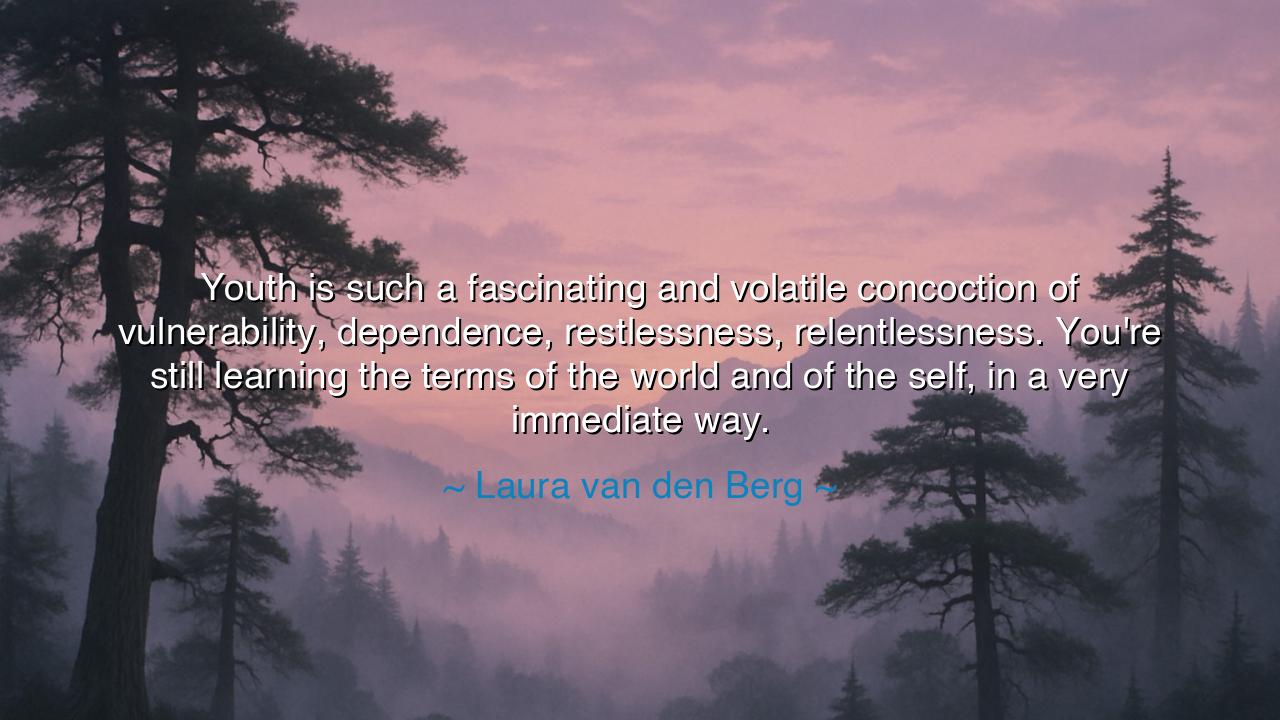
Youth is such a fascinating and volatile concoction of
Youth is such a fascinating and volatile concoction of vulnerability, dependence, restlessness, relentlessness. You're still learning the terms of the world and of the self, in a very immediate way.






The words of Laura van den Berg—“Youth is such a fascinating and volatile concoction of vulnerability, dependence, restlessness, relentlessness. You're still learning the terms of the world and of the self, in a very immediate way”—capture the sacred storm that brews in the early years of a person’s journey. The ancients might have called this the “fire of becoming,” the sacred tension between innocence and awakening. Youth is not merely an age, but an alchemy of contradictions: the tenderness of a child’s heart bound to the hunger of a soul that yearns to know, to conquer, to create. It is the hour of dawn in a lifetime, when light breaks upon the mountains of the self, and everything seems both infinite and fragile.
From the dawn of civilization, the poets and sages have marveled at the restlessness of youth. In the Greek myths, the young Icarus soared toward the sun with wings of wax, intoxicated by his own daring. His fall was not merely a tragedy, but a lesson that to be young is to live at the edge of discovery and destruction. The young do not yet fear the flame, for they are still learning its nature. That is what van den Berg means by learning “the terms of the world and of the self.” Youth is the season when one first meets the boundaries of reality — when ideals collide with imperfection, and dreams must wrestle with duty.
Yet in that collision lies something beautiful and sacred. Vulnerability, that trembling openness of the heart, is not weakness — it is the root of empathy, creativity, and courage. The dependence of youth, though often scorned, is the soil from which trust and love grow. And that restlessness, that aching desire to move, to change, to become more — it is the divine spark that propels humankind forward. The ancients knew this truth well: that a society’s future is born from the fire that burns in its youth, though that fire must be tempered with wisdom.
Consider the story of Alexander the Great, who at the age of twenty began his conquest of the known world. His youth was a whirlwind of ambition — brilliant, relentless, and often reckless. He marched through deserts and mountains, guided by visions of glory and immortality. Yet within that restless pursuit lay the vulnerabilities of youth: loneliness, yearning for validation, and the shadow of mortality. His triumphs and his tragedies are both born from that same volatile mixture van den Berg describes — relentlessness entwined with vulnerability, courage intertwined with confusion.
To understand youth, then, is to see it as both a gift and a trial. It is the forge where identity is tempered and the heart learns to bear both joy and loss. Those who are young often believe they must define everything at once — love, purpose, success — but they forget that even the ancients took decades to understand the sacred laws of the self. The immediacy of youth makes every emotion feel eternal, every failure fatal, and every dream divine. But this intensity is not meant to last forever; it is meant to awaken the soul.
For those who have passed beyond youth, there lies a sacred duty: to guide, not to scold. To remind the young that their confusion is not a curse, but the echo of creation itself. To reassure them that to be volatile is to be alive, that to question is to grow, and that the chaos they feel is the soil in which wisdom will one day take root. For wisdom without the memory of youth is dry, and youth without the guidance of wisdom is wild flame.
So, let every generation remember: Youth is sacred because it is unfinished. It is a time not to perfect, but to seek. Do not rush to tame your restlessness or bury your vulnerability. Walk boldly, make errors, fall and rise again, for that is how one learns the true “terms of the self.” The wise do not seek to escape their youth — they seek to understand it, to honor its energy while shaping it with patience. In that balance lies the eternal rhythm of life: the fire of youth and the calm of age, each completing the other like day and night upon the wheel of time.






AAdministratorAdministrator
Welcome, honored guests. Please leave a comment, we will respond soon